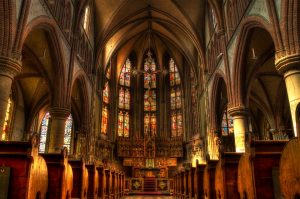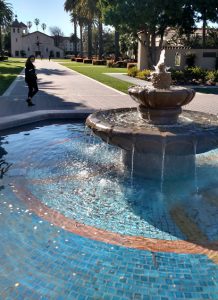 Why aren’t people coming to Church? People have always found God in nature, their everyday lives, and their prayer and celebrations at home. Many people now have different maps. They have different ways in which they arrange their lives. Where is worship in today’s society? How is it happening?
Why aren’t people coming to Church? People have always found God in nature, their everyday lives, and their prayer and celebrations at home. Many people now have different maps. They have different ways in which they arrange their lives. Where is worship in today’s society? How is it happening?
We have all kinds of maps. Our homes (blueprints), our communities, the world, and even the known universe. These physical mental maps shape the way we see things and feel about them. So where does worship fit into our map? There is the physical location of the church. But there are other maps. Where do we meet and see God in our lives? What does it mean to be a Catholic Christian in the business world, the entertainment world, the world of social media?
If you’re having a barbeque in your backyard, we can say that it located in your patio by your pool. In another sense, we can say that it is located among your network of family and friends. It is located in your social network. We can say that is is bounded or that its boundaries are your house and your back fence. However, we can also say that the boundaries of your backyard barbeque are the relationships you have with family and friends.
In general, formal liturgy is not in our backyards by the pool. However, liturgy is not only just inside the Church building, because liturgy is how we celebrate what God is doing in our lives. Worship is our response to God’s overflowing, unceasing love and grace. So it happens outside of Church in our wonder at nature and in our personal devotions in our homes, which are also called the “domestic Church.”
Boundaries, Maps, and Boundedness
In his book The Liturgy of Life: The interrelationship of Sunday Eucharist and Everyday Worship Practices, Fr. Ricky Manalo talks about the various physical regions within the church building which are defined by their purposes. They are also related to cognitive and emotional states that are bounded by social and cultural concepts, images, and archetypes. As ministers / administrators of the sacred liturgical space, we are faced with mundane questions at the beginning and sometimes throughout the Sunday liturgy. “Where is everyone?” and “What can we expect from this week’s collection?” These questions might seem unworthy of us, but they can lead us to ask deeper questions about the lack of religious observance and the spiritual needs of those whose hands are not moistened by the holy water font. I believe that looking at boundedness can give new horizons to discover the work of the Holy Spirit in our midst.
There are cosmic, social, and individual states of boundedness that are physical, cognitive, and emotional. In our homes, we have physical, social, and emotional spaces such as the kitchen, the living room, bedrooms, and the bathroom. These physical boundaries evoke a much deeper sense of boundedness. In our homes and in our lives more broadly, we have public, liminal (transitional), and private spaces. In many respects, “source and summit” can be defined as a state that is bounded. Rahner and Phan expanded Vatican II’s concepts and statements about the “source and summit” of our faith.This expansion gave us a much larger map of “source and summit” beyond the formal celebration of the Eucharist. Rahner gives us the cosmic boundedness of creation held in being and continuously created and healed that echoes the Divine Milieu of Chardin. Phan bridges the divide between formally prescribed liturgical ritual and the messy creativeness of popular religiosity in the awareness of the divine and its celebration primarily, but not exclusively, outside the physical walls of the church building.

Beyond a sense of physical space, boundedness refers to the influence of external conditions. This diagram from the environmental website Inhabitat.com shows various physical and biological states that determine the viability of life on the planet. These are boundary states. For example, genetic diversity has decreased below a safe level. The remaining species might be wiped out by a sudden disease or event because the diversity of these species is lacking. The potato famine in Ireland is a case in point. There was little diversity and when the dominant variety of potatoes was destroyed by a blight in the mid-1800s, thousands of people starved to death. A review of this chart shows which environmental factors are within safe limits and those that are not for life on space ship Earth.

Shifting our focus from the planet to our Life in the Spirit, we can look at three boundary conditions of “source and summit.” We experience God as “source and summit” in our personal mystical experience in nature and everyday life. We also have experiences of God in our prayers and celebrations at home. Of course, we are used to thinking of encountering God in formal services, “cultic behavior” in church buildings. If we look at this diagram as a continuum, we can see that the varying approaches of Fr. Manalo’s study participants focused on various parts of the spectrum relative to their experience of the origin points of their primary experience of meaning (source) and their customary points of their peak experiences of peace-filled transcendence (summit).
Although, each of the participants in the study had an affiliation with St. Agnes Parish, their attendance at Sunday Mass varied extensively despite being deeply spiritual / religious people with rich inner lives and exemplary public lives. Clearly, our place on this transcendental spectrum can change throughout the day, from day to day, and month to month.
If we look at declining rates of Sunday observance by Catholics and devotional practice, we might see them as a shift from public expression to a more interior disposition. American cultural disillusionment with its own civil and religious institutions is shown by the lack of moral leadership these institutions are accorded. The sex abuse crisis has also converted institutional Catholicism into a place of danger and moral indifference in the view of many Catholics.
The other cultural factor facing American Catholicism is the broadening of these states of boundedness or membership since Vatican II, as demonstrated in the thought of Karl Rahner and Peter Phan. Rahner talks about the “anonymous” Christian. This is a person who may never have heard of Christ but is nevertheless touched and guided by the Holy Spirit, since God’s love is never limited by what we do or do not do. Peter Phan has refocused the idea of the source and summit of our lives to be God. He makes the point that God is active in our private devotions and in all of creation. The Second Vatican Council re-asserted the ancient teaching from the Gospels that the Holy Spirit is leading people in a variety of ways. We do not save ourselves. Clearly, the Church emphasizes the dignity of the human person in the sacrosanct inner core of conscience. This effectively encourages an emphasis on the heart as opposed to the false security of merely observing institutional mandates.
Perhaps, the bigger question for us as ministers is why people are finding more meaning in the informal worship (popular religion) of traditional devotions, evangelical churches, or the New Age folks who refer to the Supreme Being as “the Universe.” The boundary conditions for religion and spirituality in our current culture have shifted. To a degree this is the result of bigger social and cultural boundary conditions regarding what it is to be an American. In the past, Americans were defined by their church membership, ethnicity, service clubs, neighborhoods, obedience to authority, and trust in the democratic process. Religious people used to be defined more narrowly by their church attendance and adherence to rules, such as not eating meat on Friday, going to Confession (Reconciliation) on Saturdays, and attending Catholic schools and universities. To be an American is something much broader these days and so is being a Catholic Christian. We are unlikely to change this constellation of economic and social forces in an era of social media.
Perhaps the way for people to find their way to the cultic end of the spectrum and into our churches is to engage people through work for peace and justice. The other is, of course, to be with people and listen to them without an agenda. In today’s boundaries, we find that experiencing and sharing in God, the source and summit, is something we do with others. Heart speaks to heart – Cor ad cor loquitor – as St Augustine said of his own conversion.
Read More











 Why aren’t people coming to Church? People have always found God in nature, their everyday lives, and their prayer and celebrations at home. Many people now have different maps. They have different ways in which they arrange their lives. Where is worship in today’s society? How is it happening?
Why aren’t people coming to Church? People have always found God in nature, their everyday lives, and their prayer and celebrations at home. Many people now have different maps. They have different ways in which they arrange their lives. Where is worship in today’s society? How is it happening?




















